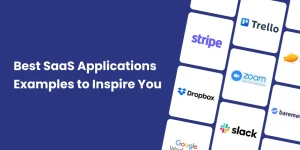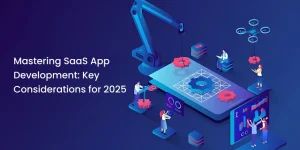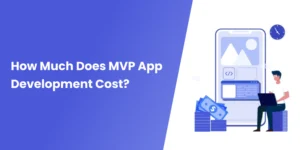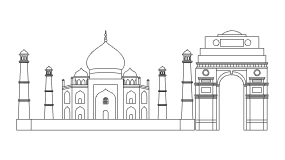What is SaaS MVP Development? Benefits, Process & Cost Explained
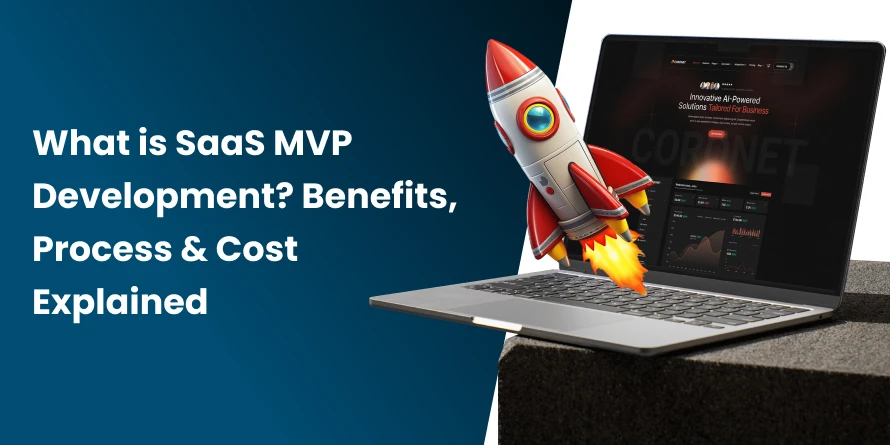
The SaaS industry is experiencing explosive growth, but with this boom comes fierce competition and rapidly rising user expectations. In a landscape where hundreds of SaaS startups launch yearly and the odds of building a truly unique product are slim, standing out requires more than just a great idea – it demands strategic execution and agility.
This is where SaaS MVP development becomes a game-changer. Rather than investing months (and massive budgets) into building a fully-featured product, a SaaS MVP lets you launch a streamlined version focused on core features.
By embracing the MVP approach, SaaS founders can validate market demand, minimize risk, and iterate quickly, ensuring their solution truly resonates with users. In today’s hyper-competitive SaaS market, building and testing an MVP isn’t just a smart investment, it’s essential for long-term success.
What is SaaS MVP?
A SaaS MVP (Minimum Viable Product) is the initial, most essential version of a SaaS application that delivers its core value with the least amount of features. It’s designed to test the product idea in the real market, attract early adopters, and gather feedback before investing in full-scale development.
Think of it like the pilot episode of your SaaS journey — just enough features to attract users and prove your idea, without getting slowed down by extra features or long development times. The goal is simple: launch fast, learn from real users, and improve based on their feedback.
SaaS Market Overview
The SaaS industry is on an unstoppable trajectory, transforming how businesses operate and how software is built, delivered, and scaled.
If you are thinking about building a SaaS app, you’re entering a market that’s not just booming – it’s rewriting the rules of digital business.
Let’s talk numbers:
- The global SaaS market is anticipated to skyrocket from around $408 billion in 2025 to a staggering $1.25 trillion by 2034, with a healthy CAGR of more than 13%.
- In fact, by 2025, SaaS is projected to power 85% of all business applications, making cloud-based solutions the new normal for organizations globally.
- Companies now use an average of 112 SaaS tools, and larger enterprises can juggle more than 400 different SaaS apps to keep their operations running smoothly.
- North America continues to dominate the SaaS landscape, holding nearly half of the global market share, but regions like India are catching up fast.
- The U.S. remains the epicenter for SaaS innovation, with over half of all SaaS companies based there and venture capital pouring in to fuel new ideas and platforms.
From the above SaaS statistics, it’s proven that SaaS adoption is nearly universal- 99% of organizations use at least one SaaS app, it’s clear that the future of software is in the cloud.
Whether you’re building the next big SaaS platform or integrating SaaS tools into your business, the opportunity is massive, the competition is fierce, and the pace of innovation has never been faster.
Benefits of SaaS MVP Development
Launching a SaaS MVP gives founders a competitive edge in a fast-moving market. Here’s why it works:
- Validates Market Demand: Test your idea with real users before committing to full-scale development.
- Reduces Risk & Cost: Avoid wasting time and money on features users may never need.
- Speeds Up Time-to-Market: Get your product into users’ hands quickly and start building traction early.
- Encourages Iteration: Learn from user feedback and refine your product based on actual usage data.
- Attracts Early Investors: A working MVP demonstrates proof of concept, making it easier to secure funding.
Step-by-Step Roadmap to Building a SaaS MVP
Building a successful SaaS MVP isn’t just about coding a bare-bones product – it’s about strategically crafting a version of your software that truly tests your core idea while delivering real value.
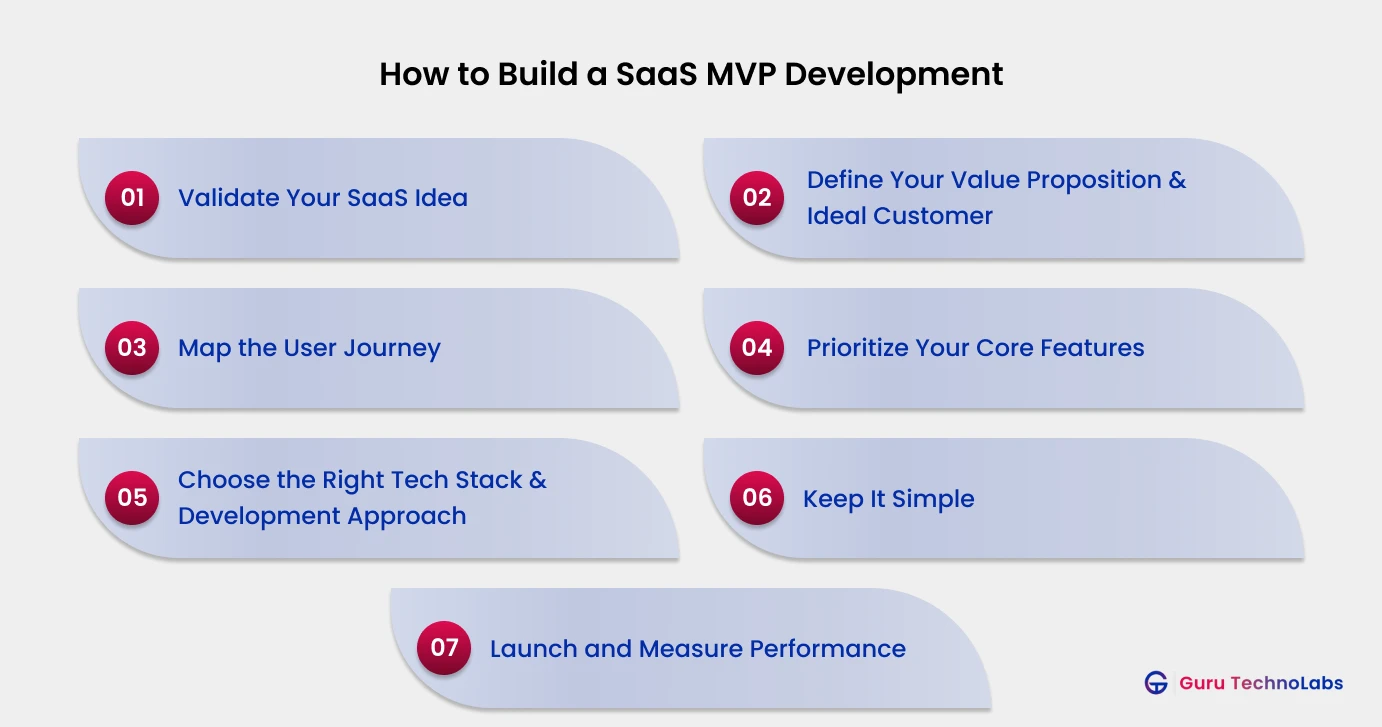
Validate Your SaaS Idea
Before writing a single line of code, make sure there’s a real market need for your product and clarity on who you’re building for. Validation confirms your idea solves a genuine problem and that people are willing to pay for the solution.
Start by researching your market — identify competitors, analyze their strengths and weaknesses, and find gaps your product can fill. Talk to potential users to learn about their biggest frustrations, what tools they currently use, and what’s missing from those solutions.
For example, if you’re building a SaaS tool for social media marketers at small eCommerce brands, you might discover they struggle to track campaign results across multiple platforms. That insight validates a problem worth solving and sets the foundation for defining your value proposition in the next step.
Define Your Value Proposition & Ideal Customer
Once you’ve validated your SaaS idea, the next step is to clearly define who you’re building for and why they should choose your product over others.
Start by identifying your ideal customer. Consider:
- Who will benefit most from your product?
- What are their biggest frustrations and goals?
- Are their problems urgent enough to seek a solution now?
- What tools are they currently using, and what do they dislike about them?
By understanding these points, you can shape a solution that directly addresses their most pressing needs.
From there, craft your value proposition, a clear statement that communicates the unique benefit your product delivers. It should answer:
- Why should your target user care?
- What is the key advantage only you can offer?
For example, if you’re creating a SaaS analytics tool for social media marketers at small eCommerce brands, your value proposition might be: “One-click reporting that combines all social channels into a single dashboard — saving hours each week and eliminating manual spreadsheets.” This clarity ensures your MVP development stays focused and makes it easier to attract your first wave of enthusiastic users.
Map the User Journey
Don’t just imagine how users will interact with your SaaS MVP – walk in their shoes. Start from their very first touchpoint (may be a landing page or sign-up form) and allow every step they’ll take to achieve their goal. This process helps you spot friction points and opportunities to delight users early on.
For instance, you are building a SaaS tool for remote team collaboration. Map out how a new user – let’s call him Alex – discovers your app, signs up, invites teammates, creates a project, and shares files.
Are there confusing steps or unnecessary clicks?
By mapping Alex’s journey, you can streamline onboarding and ensure your MVP delivers a smooth, intuitive experience.
Prioritize Your Core Features
When building a B2B SaaS MVP, the goal is not to create a fully polished product but to develop a functional solution that addresses the most important pain points of your target audience.
For instance, if you are about to build a SaaS invoicing app, “create and send invoices” is a must-have, while “customizable invoice templates” or “multi-currency support” might be saved for later releases.
Focus your MVP on what solves your target user’s biggest pain points right now.
Choose the Right Tech Stack & Development Approach
Your tech stack lays the foundation for your SaaS MVP’s performance, scalability, and speed to market. Choose technologies that allow quick development without compromising future growth.
Decide whether to build with a custom-coded approach for maximum flexibility, a no-code/low-code platform for faster launch, or a hybrid model. Factor in your budget, timeline, and long-term product vision.
For example, a no-code tool might get you to market in weeks, while a custom build can better handle complex features and scaling needs. The right choice ensures you can launch fast now and evolve smoothly later.
Keep It Simple
Simplicity is your MVP’s superpower — both in how it looks and how it works. A clean, uncluttered interface makes it easy for users to navigate, while focusing on essential functionality ensures they can quickly achieve their goals without confusion.
Avoid overloading your MVP with advanced features or complex workflows. Instead, prioritize clarity, speed, and ease of use. Pixel-perfect design can wait — what matters most is that users instantly understand your product’s core value.
For example, if you’re building a SaaS scheduling tool, don’t launch with every calendar integration on day one. Start with Google Calendar and a basic drag-and-drop interface. This approach gets your solution into users’ hands faster and gives you space to iterate based on real-world feedback.
Launch and Measure Performance
Just launching the MVP is not enough. You must evaluate its success and monitor key performance indicators to ensure your MVP is performing as per the expectation and solves the user’s problem effectively.
Start by identifying the key performance indicators (KPIs) essential for evaluating your MVP’s success. Well-defined and reliable KPIs provide a clear benchmark for measuring progress and determining what’s working.
Here are some critical KPIs to track for SaaS MVP:
- Customer Acquisition Cost (CAC): How much do you spend to gain each new customer?
- Monthly Recurring Revenue (MRR): What is your consistent monthly income from subscriptions?
- Churn Rate: What percentage of users cancel or stop using your service within a given timeframe?
- Customer Lifetime Value (CLTV): How much total revenue is expected from a customer throughout their relationship with your product?
- Trial-to-Paid Conversion Rate: What proportion of free trial users end up becoming paying customers?
Monitoring user activity is vital to understanding long-term product value and user satisfaction. Key engagement metrics include:
- Daily and Monthly Active Users (DAU/MAU): How many users log in and use your service daily or monthly?
- Average Session Length: How long does the average user interact with your product in a single visit?
- Use Retention: How many users continue to use your product over time?
Studying these conversion metrics helps you spot weak points in your acquisition funnel and fine-tune your strategy for better results. Running A/B tests across different user flows and touchpoints can significantly enhance your conversion optimization efforts.
SaaS MVP Examples
Looking for inspiration to build your own SaaS MVP? These well-known companies started with simple, focused solutions – proof that a powerful product doesn’t need to be perfect at launch.
Let these SaaS app examples show you how starting small can lead to something big.
- Spotify: Launched with a desktop-only MVP that offered music streaming for free with ads. Once traction grew, they expanded to mobile apps and a premium subscription.
- Dropbox: Began with a short explainer video demonstrating how the product worked. The overwhelming interest helped validate demand before building the full platform.
- Buffer: Started as a basic landing page to test interest in scheduling tweets. Based on user feedback, they gradually built out features for more platforms and analytics.
- Canva: Introduced a simple drag-and-drop design tool for non-designers. As usage increased, they added templates, brand kits, and team collaboration tools.
- Zapier: Initially built a handful of integrations manually to test interest in workflow automation. With proven demand, they opened up access to thousands of app connections.
How Much Does SaaS MVP Development Cost?
The cost of building a SaaS MVP can vary widely, from $10,000 to over $100,000+, depending on several factors. Here’s a breakdown of what impacts your budget:
Scope & Complexity of Features
The more features you include, the higher the cost. A simple MVP with core functionality will be more affordable than one with complex integrations, AI tools, or advanced analytics.
Design & User Experiences (UX)
Clean, intuitive design takes time and skill. Custom UI/UX design adds polish and professionalism, but also increases development time and cost.
Development Team Location
Rates vary by region:
- U.S. / Canada: $100 – $200/hour
- Western Europe: $60-$120/hour
- Eastern Europe: $30-$60/hour
- Asia/ Latin America: $20 -$50/hour
In-house vs Outsourcing
Hiring an in-house team gives you more control but comes with higher overhead. Outsourcing or working with freelancers / remote teams can significantly reduce costs.
Technology Stack
Using open-source tools or no-code/low-code platforms can lower your budget. Custom tech stacks may require more time and skilled developers.
Time to Market
Tight deadlines often mean more developers (and cost) to speed up delivery. A longer timeline can stretch out expenses but reduce peak costs.
Post-launch Maintenance & Updates
Your MVP isn’t done after launch. Set aside 10-20% of your initial budget for bug fixes, improvements, and server costs after going live.
Pro Tip: Start lean – focus on the “must-have” features that solve the core user problem. Build smart, test fast, and scale based on feedback.
Also Read: How Much Does It Cost to Build MVP App?
How Can Guru TechnoLabs Help In Building a SaaS MVP
Building a SaaS MVP requires more than just coding — it’s about choosing the right features, validating ideas quickly, and ensuring your product is ready to evolve based on real user feedback.
Guru TechnoLabs offers MVP app development services designed to help you launch a lean yet impactful version of your product. We focus on delivering core functionality that solves your users’ most pressing problems, while setting the stage for smooth future enhancements.
As an experienced SaaS app development company, we combine technical expertise with a deep understanding of product strategy. From defining the roadmap to building and refining your MVP, we work alongside you to ensure your solution is market-ready, scalable, and aligned with your business goals.
Frequently Asked Questions
A minimum viable product (MVP) in SaaS means an early version of a product that has only the core features but offers optimum value to customers.
Yes. A SaaS MVP can be built without coding skills, and tools like Bubble, Adalo, Webflow, etc., allow entrepreneurs to create functional prototypes and launch an MVP without writing a single code.
Anywhere from a few hundred dollars to hundreds of millions, depending on the complexity of the software developed, the design, the framework, etc.



